instrument cluster BUICK CENTURY 2005 Owner's Manual
[x] Cancel search | Manufacturer: BUICK, Model Year: 2005, Model line: CENTURY, Model: BUICK CENTURY 2005Pages: 348, PDF Size: 2.32 MB
Page 87 of 348
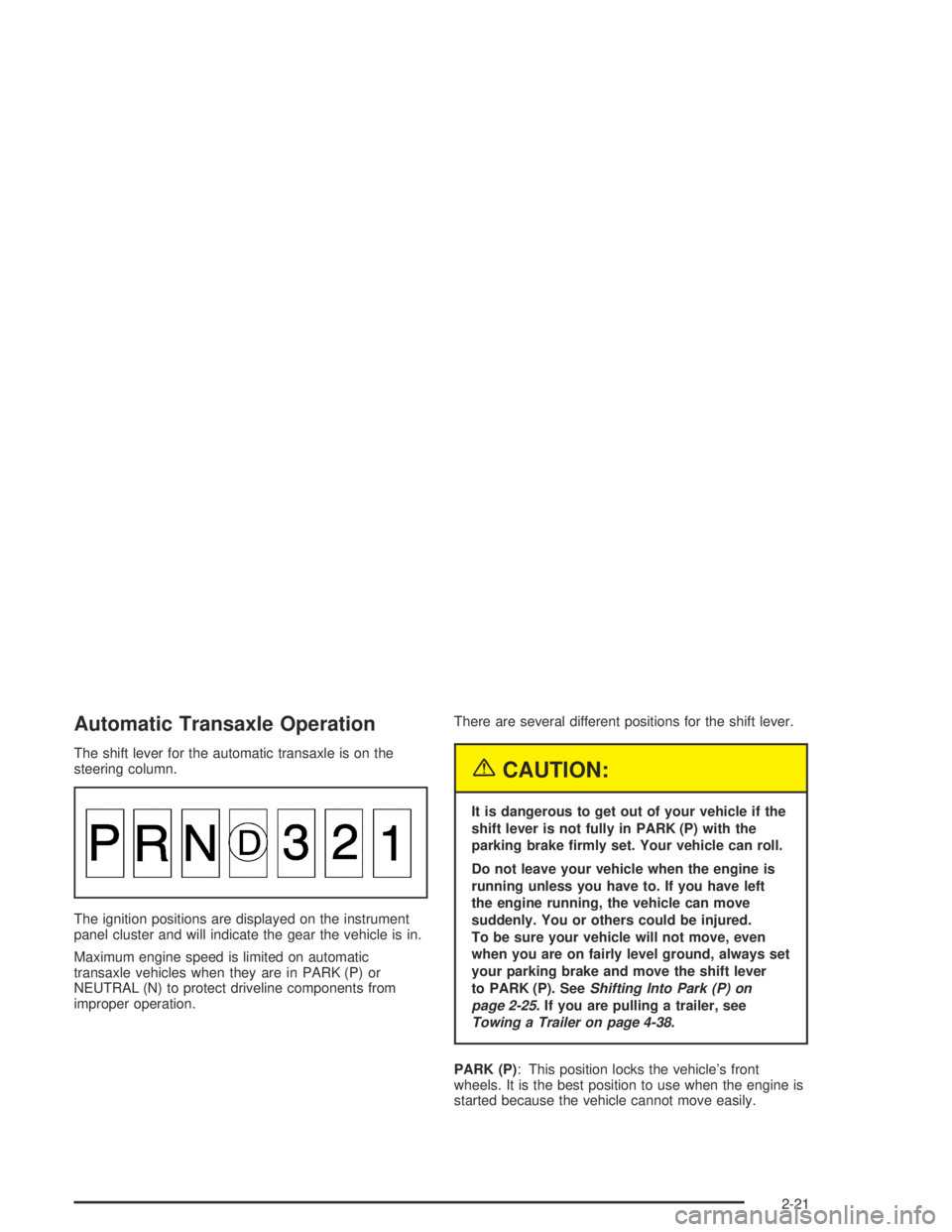
Automatic Transaxle Operation
The shift lever for the automatic transaxle is on the
steering column.
The ignition positions are displayed on the instrument
panel cluster and will indicate the gear the vehicle is in.
Maximum engine speed is limited on automatic
transaxle vehicles when they are in PARK (P) or
NEUTRAL (N) to protect driveline components from
improper operation.There are several different positions for the shift lever.
{CAUTION:
It is dangerous to get out of your vehicle if the
shift lever is not fully in PARK (P) with the
parking brake �rmly set. Your vehicle can roll.
Do not leave your vehicle when the engine is
running unless you have to. If you have left
the engine running, the vehicle can move
suddenly. You or others could be injured.
To be sure your vehicle will not move, even
when you are on fairly level ground, always set
your parking brake and move the shift lever
to PARK (P). SeeShifting Into Park (P) on
page 2-25. If you are pulling a trailer, see
Towing a Trailer on page 4-38.
PARK (P): This position locks the vehicle’s front
wheels. It is the best position to use when the engine is
started because the vehicle cannot move easily.
2-21
Page 101 of 348
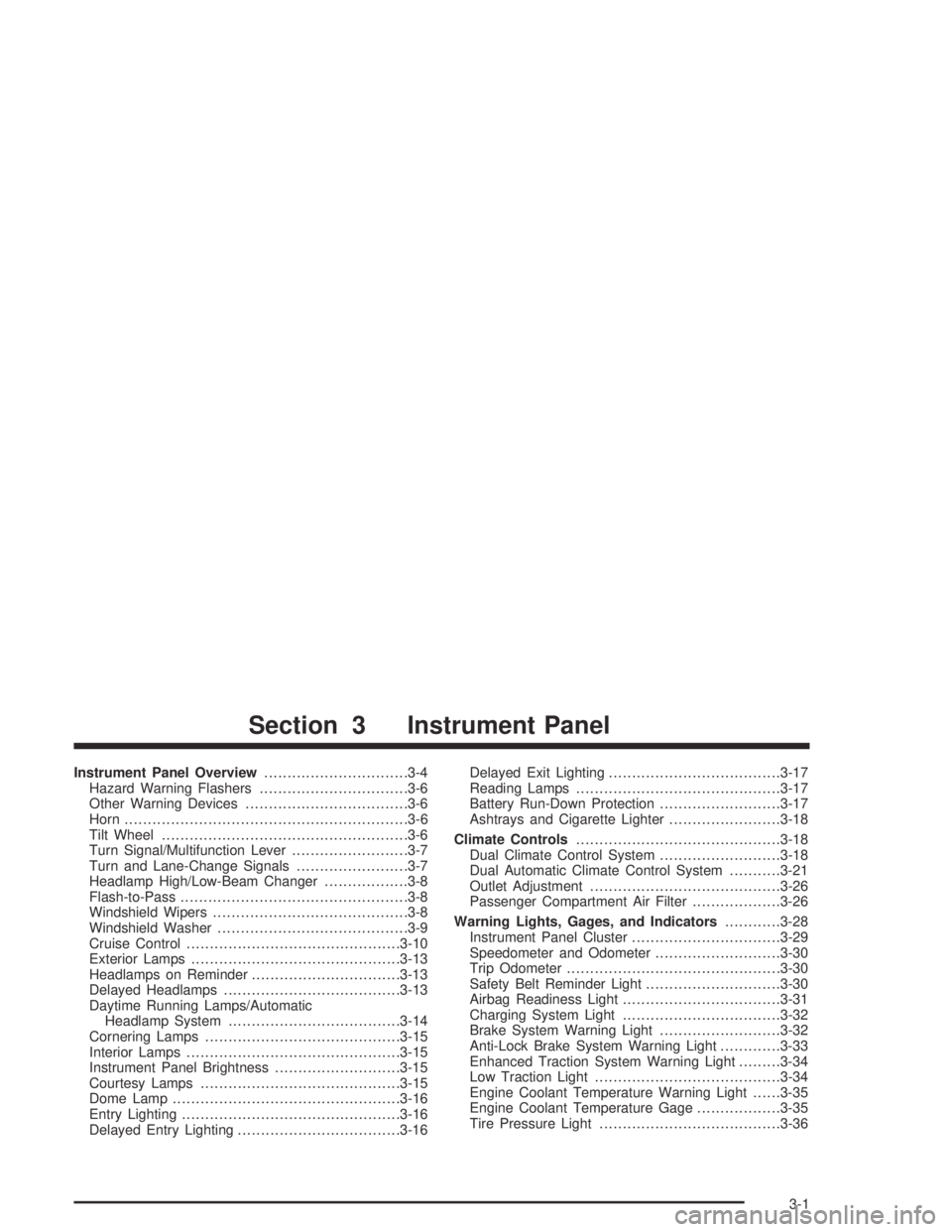
Instrument Panel Overview...............................3-4
Hazard Warning Flashers................................3-6
Other Warning Devices...................................3-6
Horn.............................................................3-6
Tilt Wheel.....................................................3-6
Turn Signal/Multifunction Lever.........................3-7
Turn and Lane-Change Signals........................3-7
Headlamp High/Low-Beam Changer..................3-8
Flash-to-Pass.................................................3-8
Windshield Wipers..........................................3-8
Windshield Washer.........................................3-9
Cruise Control..............................................3-10
Exterior Lamps.............................................3-13
Headlamps on Reminder................................3-13
Delayed Headlamps......................................3-13
Daytime Running Lamps/Automatic
Headlamp System.....................................3-14
Cornering Lamps..........................................3-15
Interior Lamps..............................................3-15
Instrument Panel Brightness...........................3-15
Courtesy Lamps...........................................3-15
Dome Lamp.................................................3-16
Entry Lighting...............................................3-16
Delayed Entry Lighting...................................3-16Delayed Exit Lighting.....................................3-17
Reading Lamps............................................3-17
Battery Run-Down Protection..........................3-17
Ashtrays and Cigarette Lighter........................3-18
Climate Controls............................................3-18
Dual Climate Control System..........................3-18
Dual Automatic Climate Control System...........3-21
Outlet Adjustment.........................................3-26
Passenger Compartment Air Filter...................3-26
Warning Lights, Gages, and Indicators............3-28
Instrument Panel Cluster................................3-29
Speedometer and Odometer...........................3-30
Trip Odometer..............................................3-30
Safety Belt Reminder Light.............................3-30
Airbag Readiness Light..................................3-31
Charging System Light..................................3-32
Brake System Warning Light..........................3-32
Anti-Lock Brake System Warning Light.............3-33
Enhanced Traction System Warning Light.........3-34
Low Traction Light........................................3-34
Engine Coolant Temperature Warning Light......3-35
Engine Coolant Temperature Gage..................3-35
Tire Pressure Light.......................................3-36
Section 3 Instrument Panel
3-1
Page 105 of 348
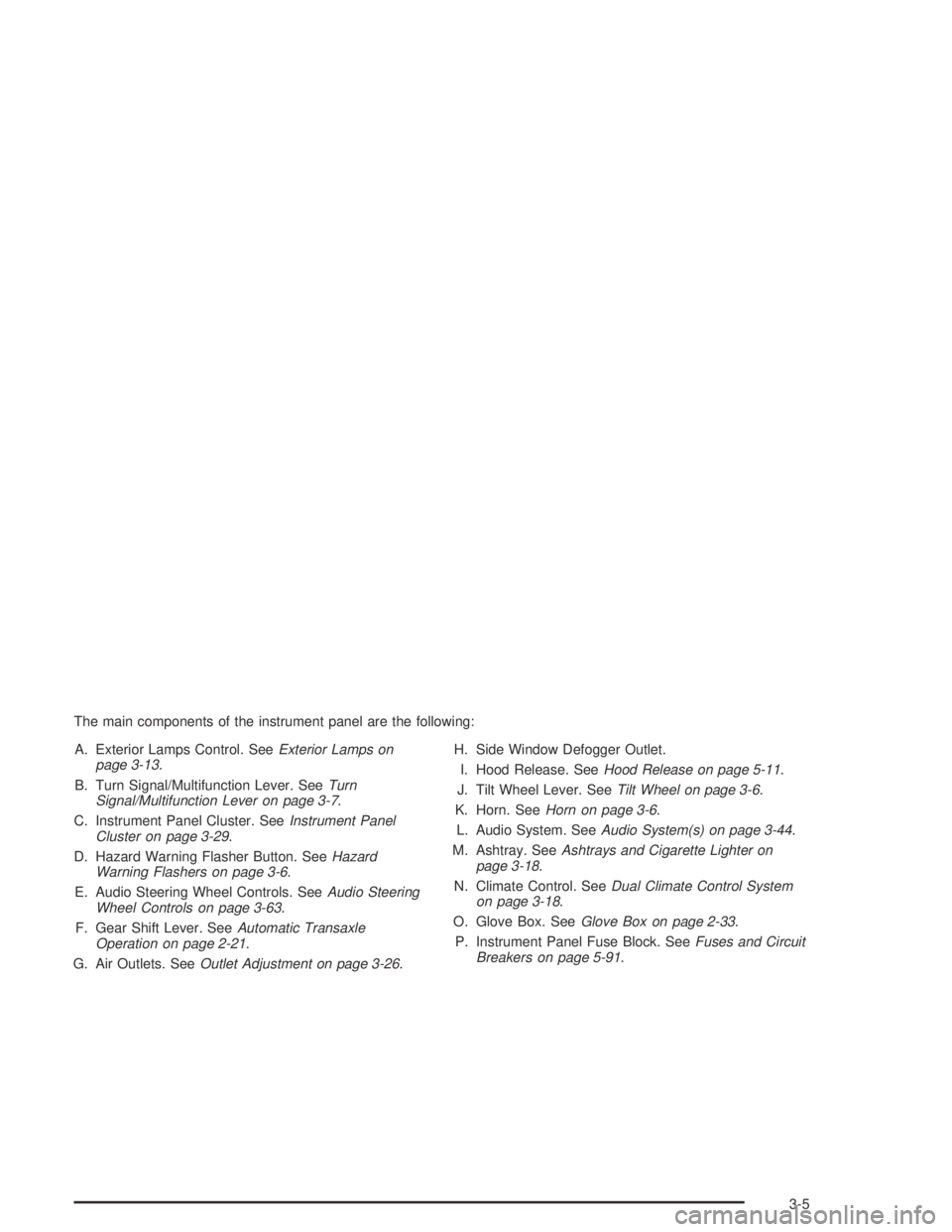
The main components of the instrument panel are the following:
A. Exterior Lamps Control. SeeExterior Lamps on
page 3-13.
B. Turn Signal/Multifunction Lever. SeeTurn
Signal/Multifunction Lever on page 3-7.
C. Instrument Panel Cluster. SeeInstrument Panel
Cluster on page 3-29.
D. Hazard Warning Flasher Button. SeeHazard
Warning Flashers on page 3-6.
E. Audio Steering Wheel Controls. SeeAudio Steering
Wheel Controls on page 3-63.
F. Gear Shift Lever. SeeAutomatic Transaxle
Operation on page 2-21.
G. Air Outlets. SeeOutlet Adjustment on page 3-26.H. Side Window Defogger Outlet.
I. Hood Release. SeeHood Release on page 5-11.
J. Tilt Wheel Lever. SeeTilt Wheel on page 3-6.
K. Horn. SeeHorn on page 3-6.
L. Audio System. SeeAudio System(s) on page 3-44.
M. Ashtray. SeeAshtrays and Cigarette Lighter on
page 3-18.
N. Climate Control. SeeDual Climate Control System
on page 3-18.
O. Glove Box. SeeGlove Box on page 2-33.
P. Instrument Panel Fuse Block. SeeFuses and Circuit
Breakers on page 5-91.
3-5
Page 107 of 348

Turn Signal/Multifunction Lever
The multifunction lever located on the left side of the
steering column includes the following:
Turn and Lane-Change Signals
Headlamp High/Low-Beam Changer
Flash-to-Pass
Windshield Wipers
Windshield Washer
Cruise Control
Turn and Lane-Change Signals
To signal a turn, move the turn signal/multifunction lever
up or down. The lever returns to its original position
when the turn is completed.
An arrow on the instrument
panel cluster will �ash in
the direction of the
turn or lane change.
To signal a lane change, raise or lower the turn signal/
multifunction lever until the arrow starts to �ash. Hold it
there until the lane change is completed. The lever will
return to its original position when released.
Arrows that �ash rapidly when signaling for a turn or
lane change, or that fail to work, may indicate a
burned-out signal bulb or fuse. Other drivers will not see
the signal. SeeFront Turn Signal and Parking Lamps
on page 5-48andTaillamps, Turn Signal, and
Stoplamps on page 5-50for turn signal bulb replacement
procedures. Also seeFuses and Circuit Breakers on
page 5-91for location of fuses.
A chime will sound if the turn signal is left on for more
than 3/4 mile (1.2 km).
3-7
Page 108 of 348

Headlamp High/Low-Beam Changer
To change the headlamps from low beams to high
beams, or high to low, pull the multifunction lever until
a click is heard, then release it.
This indicator light on the
instrument panel cluster
will come on while the
high-beam lamps are on.
Flash-to-Pass
This feature lets you use your high-beam headlamps to
signal the driver in front of you that you want to pass.
It works even if the headlamps are off. Pull the turn
signal lever toward you a little, but not so much that you
hear a click.
If the headlamps are off or on low-beam, the high-beam
headlamps will turn on. They will stay on as long as
you hold the lever toward you. The high-beam indicator
on the instrument panel cluster will come on. Release
the lever to return it to the normal operation.
Windshield Wipers
To operate the windshield wipers turn the band located
on the multifunction lever upward or downward.
WIPER:Turn this band to control the windshield wipers.
OFF:Turn the band to OFF to turn off the
windshield wipers.
LO (Low Speed):Turn the band away from you
to LO and past the delay settings for steady wiping at
low speed.
HI (High Speed):Turn the band away from you, to HI,
and past the delay settings for steady wiping at a
high speed.
(Delayed Wiping):Turn the band away from you,
just past OFF, to one of the �ve delayed settings,
to choose the length of intervals between each wiping
cycle. The further the band is turned upward, toward LO,
the shorter the delay will be. Select one of these
settings for light rain or snow.
3-8
Page 109 of 348
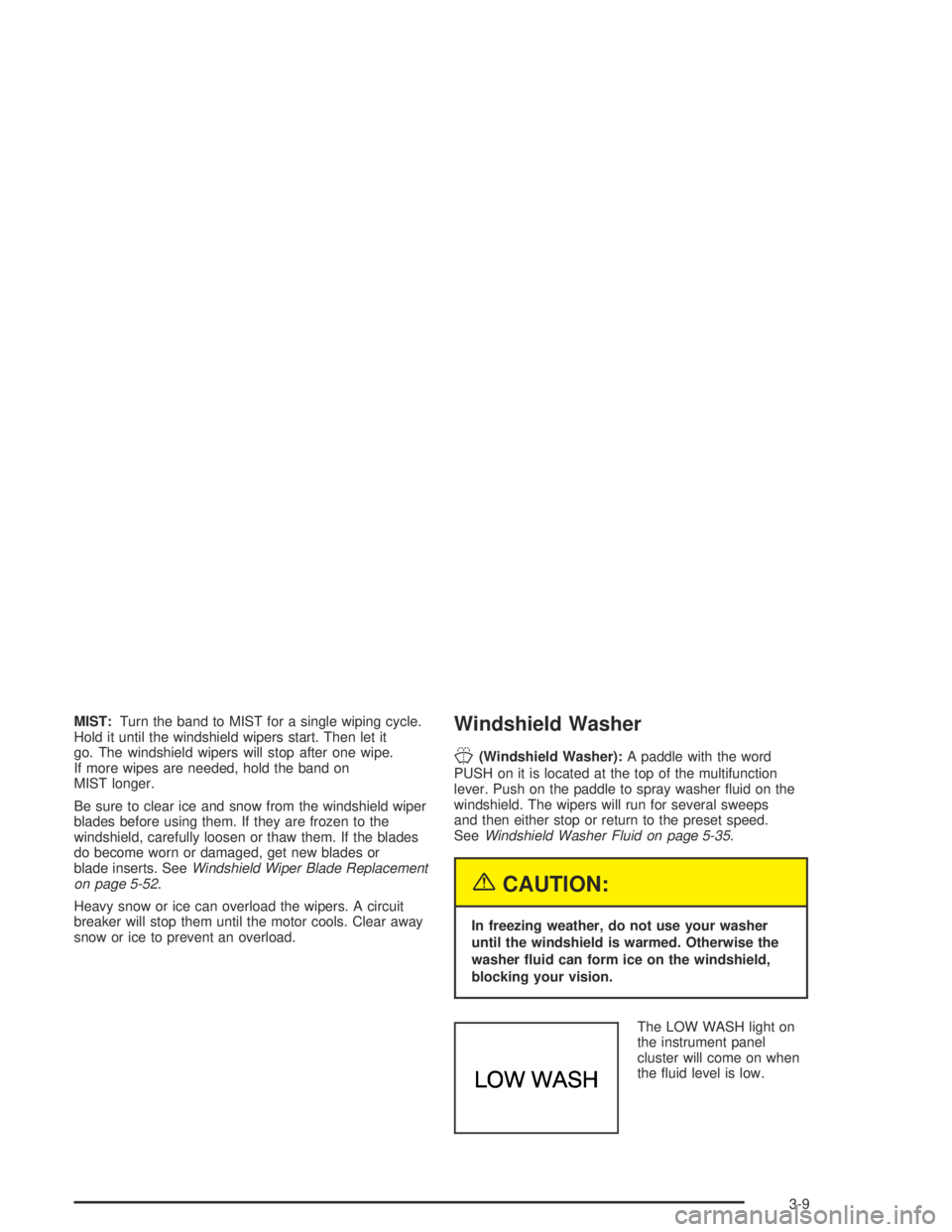
MIST:Turn the band to MIST for a single wiping cycle.
Hold it until the windshield wipers start. Then let it
go. The windshield wipers will stop after one wipe.
If more wipes are needed, hold the band on
MIST longer.
Be sure to clear ice and snow from the windshield wiper
blades before using them. If they are frozen to the
windshield, carefully loosen or thaw them. If the blades
do become worn or damaged, get new blades or
blade inserts. SeeWindshield Wiper Blade Replacement
on page 5-52.
Heavy snow or ice can overload the wipers. A circuit
breaker will stop them until the motor cools. Clear away
snow or ice to prevent an overload.Windshield Washer
J(Windshield Washer):A paddle with the word
PUSH on it is located at the top of the multifunction
lever. Push on the paddle to spray washer �uid on the
windshield. The wipers will run for several sweeps
and then either stop or return to the preset speed.
SeeWindshield Washer Fluid on page 5-35.
{CAUTION:
In freezing weather, do not use your washer
until the windshield is warmed. Otherwise the
washer �uid can form ice on the windshield,
blocking your vision.
The LOW WASH light on
the instrument panel
cluster will come on when
the �uid level is low.
3-9
Page 111 of 348
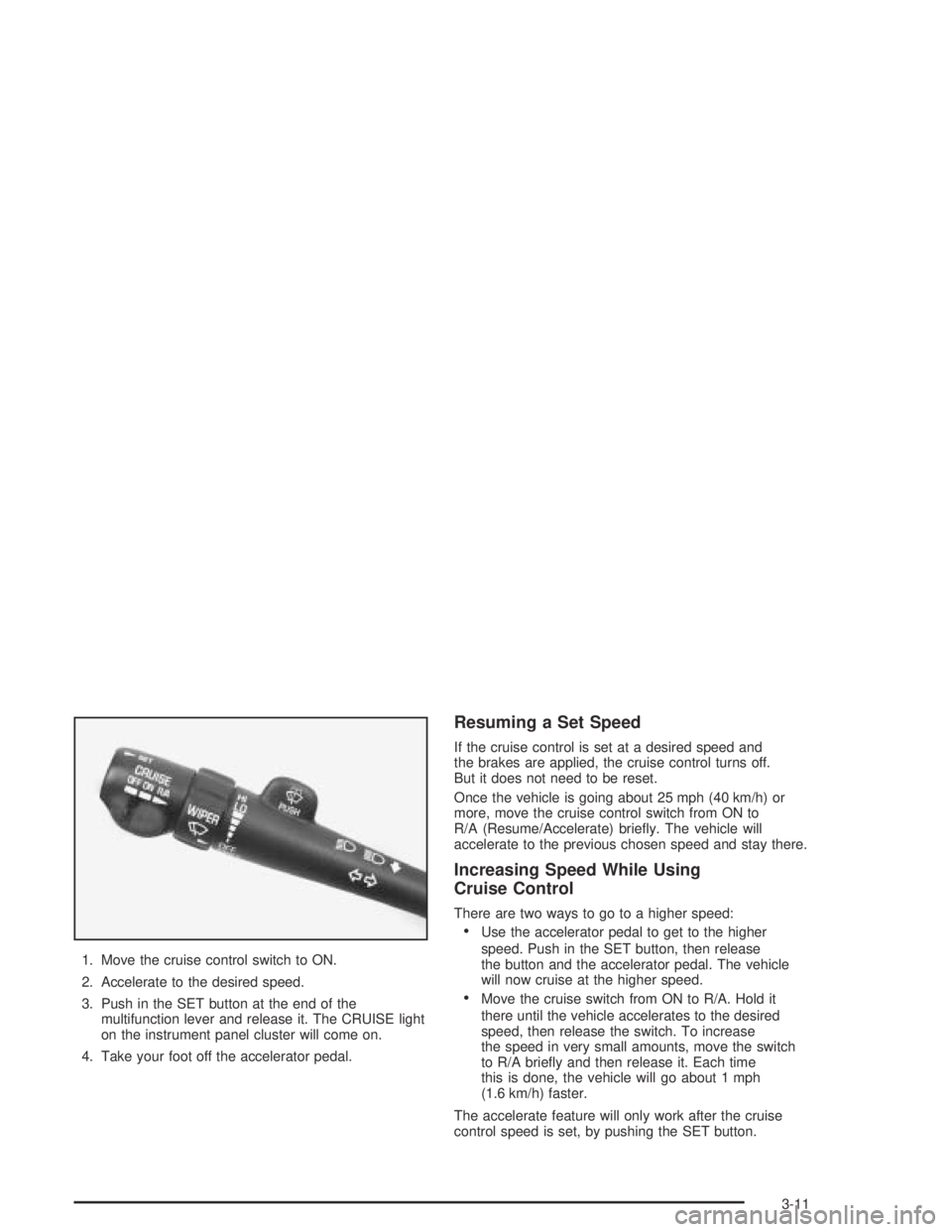
1. Move the cruise control switch to ON.
2. Accelerate to the desired speed.
3. Push in the SET button at the end of the
multifunction lever and release it. The CRUISE light
on the instrument panel cluster will come on.
4. Take your foot off the accelerator pedal.
Resuming a Set Speed
If the cruise control is set at a desired speed and
the brakes are applied, the cruise control turns off.
But it does not need to be reset.
Once the vehicle is going about 25 mph (40 km/h) or
more, move the cruise control switch from ON to
R/A (Resume/Accelerate) brie�y. The vehicle will
accelerate to the previous chosen speed and stay there.
Increasing Speed While Using
Cruise Control
There are two ways to go to a higher speed:
Use the accelerator pedal to get to the higher
speed. Push in the SET button, then release
the button and the accelerator pedal. The vehicle
will now cruise at the higher speed.
Move the cruise switch from ON to R/A. Hold it
there until the vehicle accelerates to the desired
speed, then release the switch. To increase
the speed in very small amounts, move the switch
to R/A brie�y and then release it. Each time
this is done, the vehicle will go about 1 mph
(1.6 km/h) faster.
The accelerate feature will only work after the cruise
control speed is set, by pushing the SET button.
3-11
Page 129 of 348
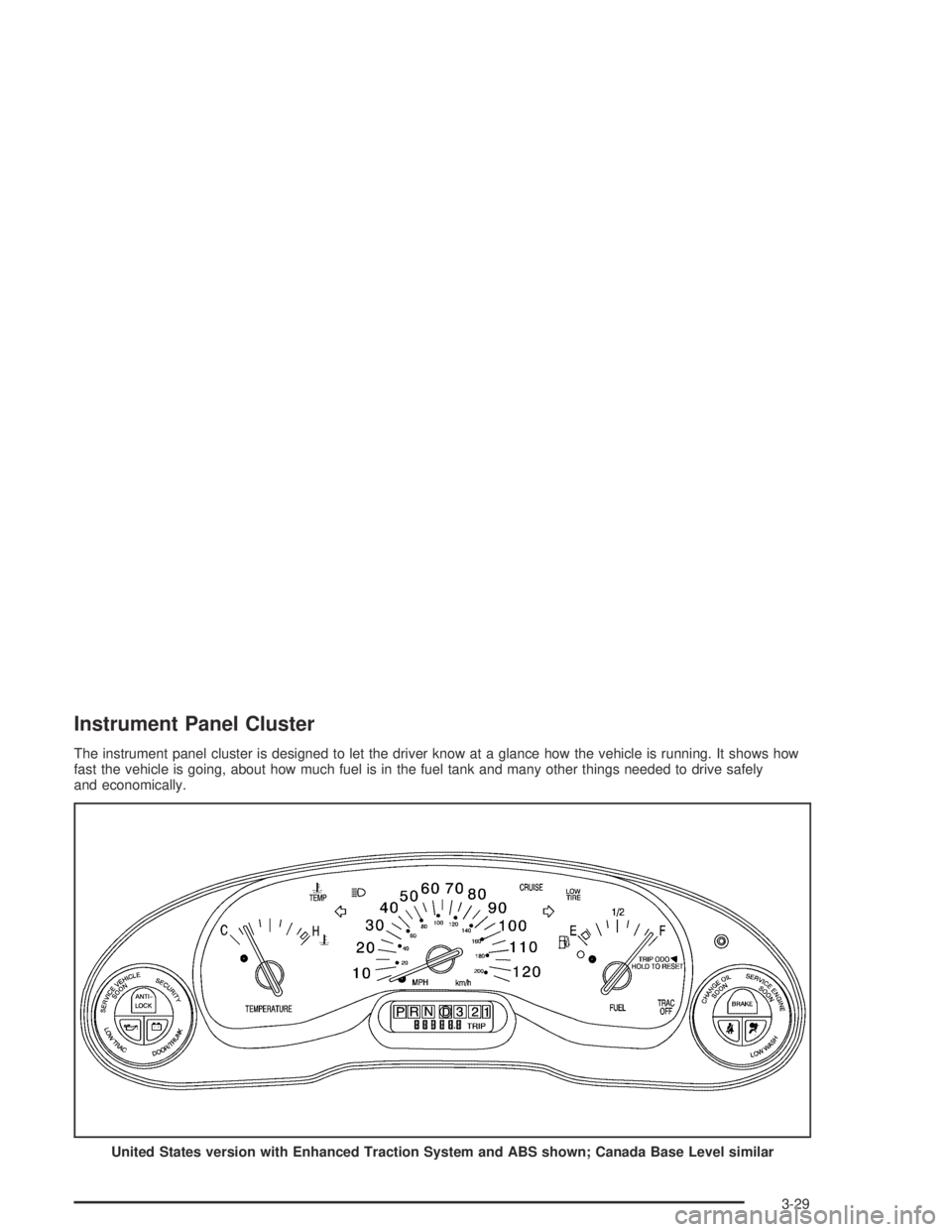
Instrument Panel Cluster
The instrument panel cluster is designed to let the driver know at a glance how the vehicle is running. It shows how
fast the vehicle is going, about how much fuel is in the fuel tank and many other things needed to drive safely
and economically.
United States version with Enhanced Traction System and ABS shown; Canada Base Level similar
3-29
Page 130 of 348
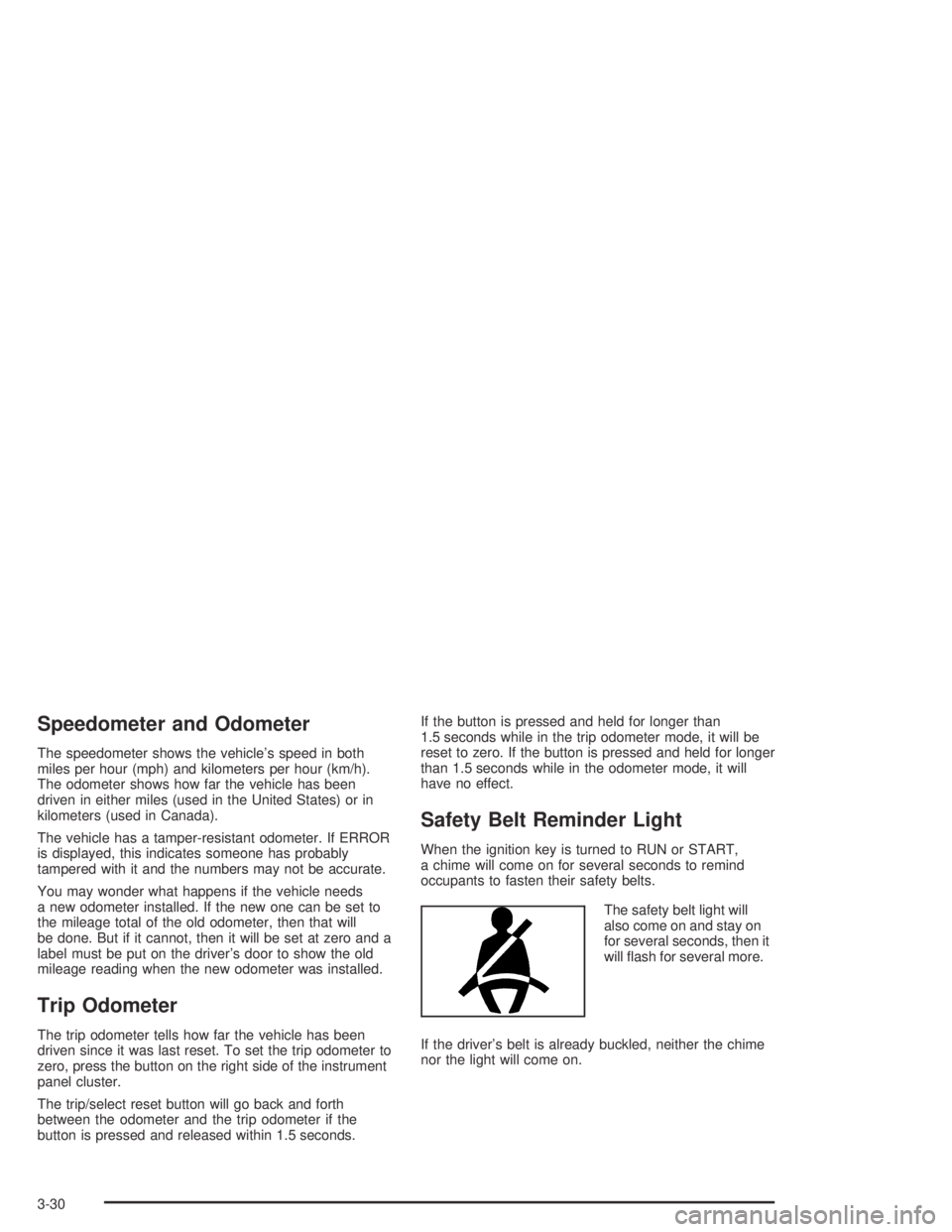
Speedometer and Odometer
The speedometer shows the vehicle’s speed in both
miles per hour (mph) and kilometers per hour (km/h).
The odometer shows how far the vehicle has been
driven in either miles (used in the United States) or in
kilometers (used in Canada).
The vehicle has a tamper-resistant odometer. If ERROR
is displayed, this indicates someone has probably
tampered with it and the numbers may not be accurate.
You may wonder what happens if the vehicle needs
a new odometer installed. If the new one can be set to
the mileage total of the old odometer, then that will
be done. But if it cannot, then it will be set at zero and a
label must be put on the driver’s door to show the old
mileage reading when the new odometer was installed.
Trip Odometer
The trip odometer tells how far the vehicle has been
driven since it was last reset. To set the trip odometer to
zero, press the button on the right side of the instrument
panel cluster.
The trip/select reset button will go back and forth
between the odometer and the trip odometer if the
button is pressed and released within 1.5 seconds.If the button is pressed and held for longer than
1.5 seconds while in the trip odometer mode, it will be
reset to zero. If the button is pressed and held for longer
than 1.5 seconds while in the odometer mode, it will
have no effect.
Safety Belt Reminder Light
When the ignition key is turned to RUN or START,
a chime will come on for several seconds to remind
occupants to fasten their safety belts.
The safety belt light will
also come on and stay on
for several seconds, then it
will �ash for several more.
If the driver’s belt is already buckled, neither the chime
nor the light will come on.
3-30
Page 143 of 348
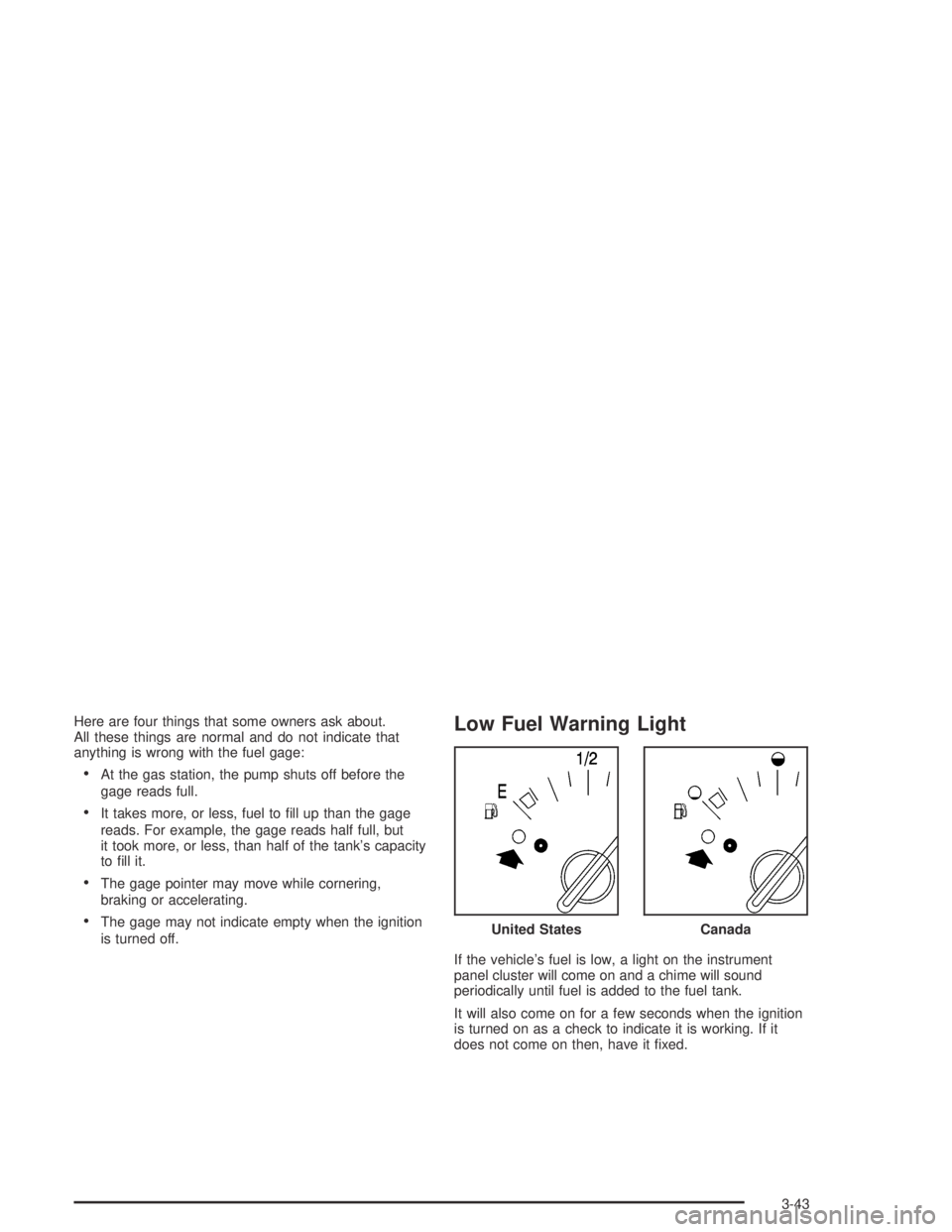
Here are four things that some owners ask about.
All these things are normal and do not indicate that
anything is wrong with the fuel gage:
At the gas station, the pump shuts off before the
gage reads full.
It takes more, or less, fuel to �ll up than the gage
reads. For example, the gage reads half full, but
it took more, or less, than half of the tank’s capacity
to �ll it.
The gage pointer may move while cornering,
braking or accelerating.
The gage may not indicate empty when the ignition
is turned off.
Low Fuel Warning Light
If the vehicle’s fuel is low, a light on the instrument
panel cluster will come on and a chime will sound
periodically until fuel is added to the fuel tank.
It will also come on for a few seconds when the ignition
is turned on as a check to indicate it is working. If it
does not come on then, have it �xed.United States
Canada
3-43